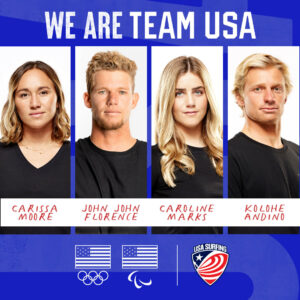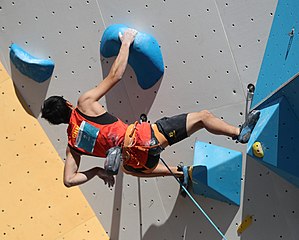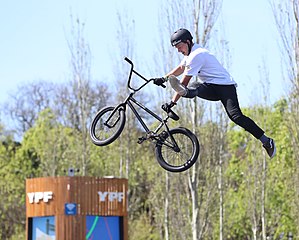During the last Olympic Games, this librarian created a short vocabulary list of Olympic terminology. With the addition of several new sports, I thought it might be appropriate to add to that list along with explanation of some lesser known and newer sports.
3×3 Basketball
Debuted in 2010 Youth Olympic Games and was chosen for the 2020 games in 2017. Three-on-three basketball uses a smaller ball (size 6), and only half of a regular sized basketball court. The game is a single period of 10 minutes with sudden death at 21 points. The winner is the first team to score 21 or the team with the higher score at the end of the 10 minutes. A tie in regulation leads to an untimed overtime period. Whichever team scores two points wins the game. Note that if a game is tied at 20 at the end of regulation, reaching 21 does not end the game. The sport, as a whole, is overseen by the International Basketball Federation (FIBA).

The US Surfing Olympic Team, photo from USA Surfing
Surfing
Surfing as a sport is broadly divided according to the size and type of the board used. The longboard is around nine feet in length and more buoyant than the shortboard, which first appeared around 1970 and is approximately six feet in length. The shortboard has a pointed tip which aids turning, is quicker to maneuver and tends to be receptive to more dynamic techniques. Shortboards will be used at the Tokyo 2020 Games, where 20 men and 20 women will compete in separate competitions. The sport, which will be new to the 2020 games is judged by the following five criteria:
According to the Salem Press Encyclopedia, surfing is one of the oldest continually practiced sports. It first developed thousands of years ago in western Polynesia. Surfing then spread to Hawaii, where it became central to ancient Hawaiian culture. Finally, the sport spread to California and the rest of the world.* Like many sports, surfing has its own culture and Wikipedia has a great list of surfing terms.
Skateboarding
There will be two different event categories for this year’s new sport. The events are street and park, both with corresponding courses. According to Olympics.com, “both the “Street” and “Park” courses have been designed with equality in mind for both regular and goofy stance skateboarders as well as all genders to compete on.” Goofy, goofy stance or goofy foot all refer to a skateboarder, snowboarder, surfer, or wakeboarder riding with his or her left foot in back, toward the tail of the board. Goofy stance gets this name because most people put their left foot forward, which is called a regular stance.
Street
This competition is held on a straight ‘street-like’ course featuring stairs, handrails, curbs, benches, walls and slopes. Each skateboarder performs individually and uses each section to demonstrate a range of skills, or ‘tricks’. Judging takes into account factors such as the degree of difficulty of the tricks, height, speed, originality, execution and the composition of moves, in order to award an overall mark.
Park
Park competitions take place on a hollowed-out course featuring a series of complicated curves — some resembling large dishes and dome-shaped bowls. From the bottom of the cavity, the curved surfaces rise steeply, with the upper part of the incline either vertical or almost vertical. Among the attractions of park competitions are the immense heights achieved by climbing the curves at speed and performing amazing mid-air tricks.
For a list of skateboarding trick names and their meanings, please click here.

Lead climbing competition in the final of the boys’ sport climbing at the 2018 Summer Youth Olympics in Buenos Aires on 10 October 2018. Martin Rulsch, Wikimedia Commons
Sport Climbing
According to USA Climbing, athletes will compete in the Combined format which will feature all three Sport Climbing disciplines – Bouldering, Lead and Speed – in one event with a total of six medals handed out to the sport’s first Olympic athletes. Each climber will compete in all three disciplines, and the final rankings will be determined by multiplying the placement in each discipline, with the athletes achieving the lowest scores winning medals.
Speed
Two climbers secure safety ropes to themselves and attempt to scale a 15m-high wall (49.2126 feet), set at an angle of 95 degrees, faster than their opponent on identical routes. Winning times for men’s events tend to be around the five to six-second mark, while women’s events are usually won in around seven or eight seconds. A false start results in instant disqualification.
Bouldering
In Bouldering, athletes climb as many fixed routes as they can within four minutes, on a 4.5m-high wall (14.7638 feet), equipped with safety mats. The routes vary in difficulty and climbers are not permitted to practise climbing them in advance. When a climber grabs the final hold at the top of a route with both hands, they are deemed to have completed it. Climbers tackle the wall without safety ropes and can try a route again if they fall during their initial attempt.
The walls used for bouldering present a range of challenges, with overhangs and some holds so small that they can only be held by the fingertips. Climbers must plan each move carefully, thinking about which hand and foot to place in the next holds, while constantly being aware of the time limit. The physical and mental dexterity required for success is extraordinary.
Lead
Lead involves athletes attempting to climb as high as they can on a wall measuring more than 15m (49.2126 feet), in height within six minutes. The climbers use safety ropes and attach the rope to quickdraws (equipment that allows the rope to run freely while leading) along the route. When a climber attaches their rope to the top quickdraw, they have completed the climb. If a climber falls, the height (hold number) attained is recorded. There are no re-climbs.
If two or more athletes complete the climb or reach exactly the same height, the fastest to do so is declared the winner. This is a demanding whole-body activity and dynamic climbing techniques are greatly important.
For a list of PPL titles on rock and mountain climbing, click here.
BMX (Bicycle Motocross)

Boys’ Qualification of mixed BMX freestyle park at the 2018 Summer Youth Olympics in Buenos Aires on 10 October 2018. Depicted: Evan Brandes.
BMX Freestyle has been around since the 1970s, but will debut at the 2020 Games. According to Union Cycliste Internationale (UCI), the governing body for all cycling sports, BMX Freestyle is a spectacular discipline where the riders perform routines which consist of sequences of executing tricks. It can be carried out in various ways such as on flat ground, in the streets, on dirt jumps, a halfpipe and on constructed ramps. In competition, riders are judged on quality of their performance (difficulty, originality and style). Listing all of the names of various tricks would make this an extremely long blog post. Here is an incomplete list of BMX terms from Alligator Pit to X-Up.
BMX Racing made its Olympic debut in Beijing 2008. BMX Racing is raced on a 350m circuit. Eight riders launch themselves from an eight-metre high ramp and race over a track alternating bumps, banked corners and flat sections. The battle for first place is fierce, as it is necessary to finish in the first four of the heats to have a place in the next round and then in the final. Depending on the lay-out of the section, the riders try either to land quickly in order to gain speed, or to gain height (riders reach up to nearly five metres high).
MOTO: A single racing heat.
BERM: An embankment on a track built up on the outside of a turn to create a banked curve.
DOUBLE: A jump where two hills are placed close together.
HOLE SHOT: Taking the lead position out of the starting gate and going into the first turn.
ROLLER: An obstacle on a track that is rolled over as opposed to being jumped.
RHYTHM SECTION: A series of jumps back to back on a track that pose as an obstacle.
SNAKE: A cut in front of someone else suddenly, disturbing their run or causing them to fall.
STAGING AREA: The area where the riders gather for loading into the gate.
STARTING GATE: Flat formed area with a hinged portion, where each race begins.
TABLE TOP: A jump on a track that is completely flat all the way across it from the takeoff to landing.
Maine in the Games
Isaiah Harris – Athletics
Rachael Schneider – Athletics
Amelia Moore – Boxing
David Hughes – Sailing
Emile Grand’Pierre – Swimming
Triston Casas (SeaDogs 1st baseman) – Baseball
Nick Rogers – Track & Field
Clara Brown – Cycling
* Biscontini, Tyler. 2017. “Surfing.” Salem Press Encyclopedia, December. https://discovery.ebsco.com/linkprocessor/plink?id=abd7d1a2-a584-37b4-9c7e-4aeb96a01f79.
posted: , by Raminta Moore